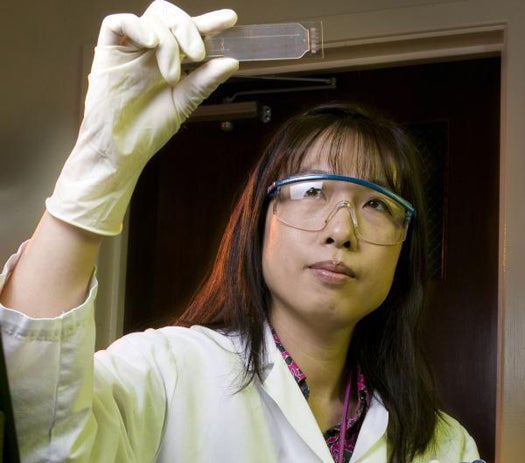A Three-Inch Bio-Detector Quickly Scans For All the Bacteria and Viruses We Know Of, All at Once
The ability to quickly detect and identify viruses and bacteria is key in fields ranging from antiterrorism to medical diagnosis...

The ability to quickly detect and identify viruses and bacteria is key in fields ranging from antiterrorism to medical diagnosis to pharmaceutical safety. A novel three-inch device created at Lawrence Livermore National Laboratory should make doing so a lot easier. The new detector can identify any of 3,000 different viruses or bacteria in just 24 hours.
The Lawrence Livermore Microbial Detection Array (LLMDA) is but a one-inch wide, three-inch long glass slide, but packed in a checkerboard pattern within the device are 388,000 probes set to detect more than 2,000 viruses and about 900 bacteria.
Each bacteria or virus that has been sequenced and included in the LLMDA has several dozen probes on board seeking out the telltale signs of that particular agent. And because each probe is individually sequenced, the device can also detect multiple pathogens — pretty much any pathogens researchers choose to include, actually — in the same sample, a remarkable upgrade from current multiplex polymerase chain reaction methods that, at the high end, can detect for a maximum of 50 or so pathogens a single test.
The process requires a purified sample of DNA or RNA, which is labeled with a fluorescent dye, then applied across the LLMDA and warmed to 107.6 degrees Fahrenheit. A fluorescent scanner then simply takes a peek. Where probes have found a sequential match, the dye lights up accordingly to mark it.
From a defense standpoint, the LLMDA could be a potential life saver, especially in the case of a sophisticated biological or chemical attack in which more than one agent is turned loose on a population at the same time. But the LLMDA has equally important yet more benign uses. It could improve food product safety, help agronomists monitor for plant pathogens, or quickly diagnose a medical problem. It already discovered a pig virus that was present in an infant vaccine from GlaxoSmithKline. The virus turned out to be harmless, but it goes to show just how groundbreaking a fast, all-seeing bio-detector could be.
Perhaps best of all, the LLMDA is completely updatable. The Livermore team is already pulling together a next-gen detector that holds 2.1 million probes that scans for signatures from 5,700 viruses and thousands of bacteria. The new detector will also add fungus and protozoa to the list of things it picks up. Being a malicious little bug just got a lot harder.